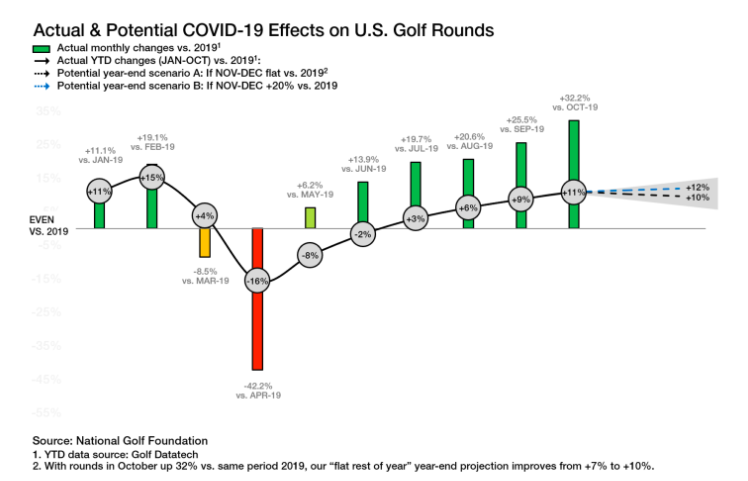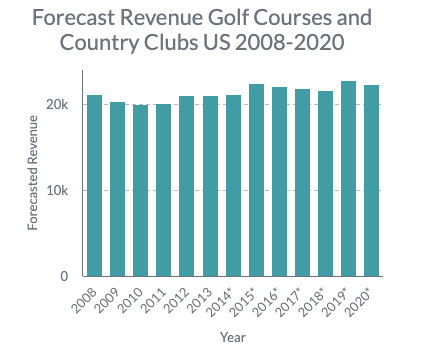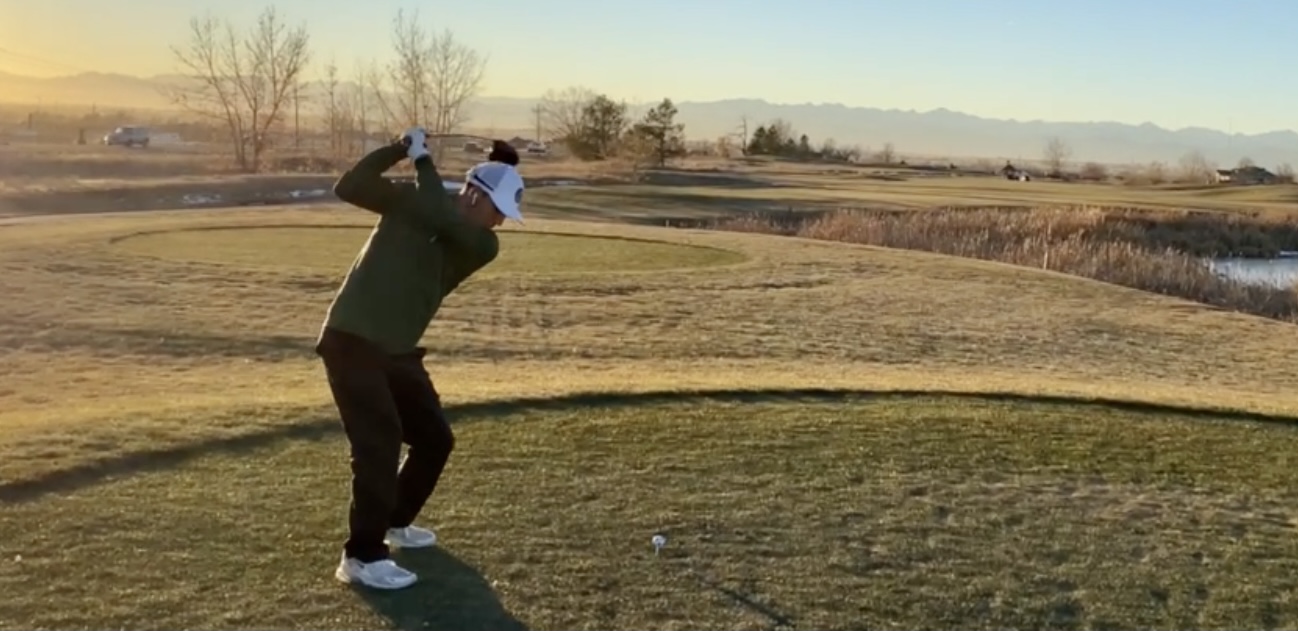By William Satler | wisa4456@colorado.edu
BRIGHTON — Getting into golf is hard enough on its own. But during a pandemic? Even harder.
So for Isaac Bugarin, a 22-year-old college student living in Commerce City, Colo., it would be hard to imagine that after going almost 10 years since last playing golf that in 2020, during the worst outbreak of a deadly virus known as COVID19 in the world since 1918, he would get back into it.
Despite all the odds, Bugarin has not only gotten into the game of golf but fell in love with it and is bringing others into the sport just the way he was brought in.
“My advice for anyone that wants to get into golf is really just become a student of the game,” Bugarin said. “I think it is important that you take the time to research the game, etiquette and figure it out what it is that makes you want to play golf more and more every single day.”
Bugarin, who had to choose between baseball and golf growing up because they generate two contrary swings, chose baseball. His decision forced him to abandon golf through his teen years, as did many others throughout the late 2000s and early 2010s.
The United States saw a slight decline from 2006 to 2017 in the amount of golfers six years and older, according to the National Golf Foundation (NGF).

But in 2018, those numbers started to change. A slight increase of about a million golfers —23.84 million golfers in 2017 to 24.3 million golfers in 2019 — showed an increase of popularity of the sport has the new decade started to near.
The decrease in popularity of the sport on the professional level, due in part to the decline and controversy that swirled around one of the greatest professional golfers of all time that came into the spotlight in the early 2000s, Tiger Woods, had a big effect on the amount of people who wanted to play the sport. Names like Justin Thomas, Dustin Johnson, Jon Rahm, and many more litter a now competitive field of exciting golfers on the PGA Tour that have exhilarated the professional realm.
The PGA Tour will only continue to grow in popularity with its upcoming 2020-2021 season looking to host 50 tournaments, which is the most since 1975.
According to the National Golf Industry, golfers played 32% more rounds of golf in October than in the same month in 2019. The last time the game of golf experience a rise in players as stark as in October? In 1997, when Woods had his breakout year on the PGA Tour.

It wasn’t just the popularity of the sport that drove away new players. The price of golf is another major factor of the amount players wanting to play and get into the game. According to the U.S. Bureau of Labor Statistics, the price index of golf courses and country clubs across America rose from 100.0 in December of 2005 to now 131.6, most recently of October this year.

According to the National Golf Industry though, that rising prices of golf were just an after thought in the third fiscal quarter of 2020. In the months of July, August, and September, golf equipment’s retail sales were north of $1 billion. Just like the amount of rounds played in October 2020 versus 1997, sales in 2020’s Q3 were the most since 2008 — the last major victory Woods had before his Masters win in 2019.
Golf, a predominantly white premium sport, is treated as an elitist activity not only in many places in America, but even more so around the world. According to the National Golf Foundation (NGF) in the 2019 Golf Industry Report, 72% of golfers in 2018 were white.

“In Croatia, the courses are absolutely beautiful,” John Forrest, an avid golfer in the Denver metro area who spent time living in Croatia in the early 2010s said. “But the game is something that only the elite play there. You just didn’t play it unless you were super rich.”
Another factor of the lack of interest of golf could be the location of where you live. In Colorado, golf players usually lose a few months out of the year to bad weather, particularly snow in the winter months. Comparatively to other sports like basketball which you can play year round inside a gym, golf is much harder to play when the sun isn’t shining at a reasonable temperature.
That has also changed in 2020 according to the National Golf Foundation, with decreased precipitation rates across the U.S. and an increase in the average temperature entering November at 57 degrees.

Bugarin credits the time disparity between sports like baseball and basketball versus a sport like golf for another important reason why golf might be a second choice for those looking to get into a sport.
“I think the biggest difference between sports like baseball and basketball versus golf is the time that you spend playing,” Bugarin said. “Baseball has innings or time limits and basketball has quarters but with golf it’s like every hole takes somewhere between 10 to 15 minutes and especially if you’re playing with other people.
“Getting through 18 [holes] or even getting through nine [holes] of golf— 18 takes about four and a half hours and 9 takes about two and a half hours — you really have to understand the time difference between the games.”
With all the odds stocked against golf though, especially during a global pandemic, it has started to grow in recent years through golfers like Bugarin. Players are finding ways through newly found time — whether from losing a job or from the increase in virtual learning/work through individual industries.

Golf courses were one of the first industries to reopen after the shutdown in the spring for the coronavirus pandemic. They provide a boost to local economies across the country while not requiring the extreme regulations that many places across the world need right now to keep patrons safe.
According to the U.S Census Bureau, golf courses and country clubs in the United States are forecasted to created $22,389 of revenue and with some regions of states with somewhere in the realm of three golf courses in every city, golf can be a huge boost to an economy, especially one that is struggling.
Over 98% of golf courses in America right now are open. During the first wave of the coronavirus pandemic in early April and May, around 50% of the courses in the United States were open, according to the National Golf Foundation. In early June, no states had any restrictions on playing, although recently that has changed.
Some courses have eliminated the use of high touch point items like water access, ball washers, and flag poles on the course as well as things like the use of golf carts and access to the center clubhouse of golf courses, known as the pro shop.
Only Hawaii among the 50 states experienced a drop in golfers, mostly because of its intense COVID19 regulations that make it extremely hard for tourists to visit the island, although this may be changing with the rise in rapid testing strategies.
The industry has remained relatively in the same area of revenue though since 2008, with around $21,181 of revenue created in that year.

Even with a second wave of COVID19 pressuring the nation, golf courses are remaining open, safely, and allow business to keep flowing.
Bugarin keeps the game interesting by not only challenging himself on the golf course every time he plays, but his opponents as well. From friendly bets to those wagers that can hurt the pockets more than the player wants, Bugarin likes the competition the course can provide.

“I’d love to win some money out of golf,” he said. “I think it’s always fun to hit the links with your friends and make a couple, friendly bets, friendly gambles, run them up whether it’s $5 a hole or $100 a hole, I think it’s always fun to win some money and win some friendly bets.”
Bugarin is just one of the wave of new golfers, or returning golfers, to the sport invigorating a sport that was once one of the most popular in America. As the pandemic lengthens, don’t be surprised to see the rise of golf continue.
Golf still has its major troubles — ethnicity inequality, high costs, as well as intrigue among young people and women —but is making a positive trend and in terms of American sports, a very rapid positive trend.
The world has changed dramatically in 2020 thanks to COVID19. From Zoom calls to masks and everything in between, the change has been stark and the world we live in is very different.
Golf too has changed. But it may be on the uprise.
